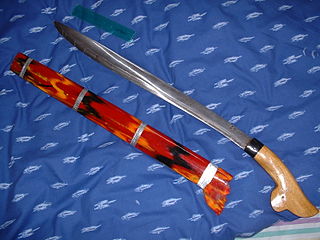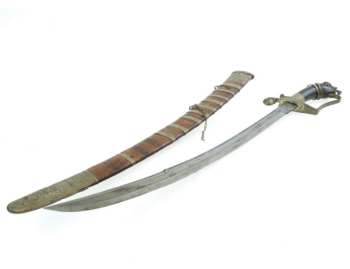A sword is an edged, bladed weapon intended for manual cutting or thrusting. Its blade, longer than a knife or dagger, is attached to a hilt and can be straight or curved. A thrusting sword tends to have a straighter blade with a pointed tip. A slashing sword is more likely to be curved and to have a sharpened cutting edge on one or both sides of the blade. Many swords are designed for both thrusting and slashing. The precise definition of a sword varies by historical epoch and geographic region.

The kukri or khukuri is a type of short sword with a distinct recurve in its blade that originated in the Indian subcontinent. It serves multiple purposes as a melee weapon and also as a regular cutting tool throughout most of South Asia. The kukri, khukri, and kukkri spellings are of Indian English origin, with the original Nepalese English spelling being khukuri.

A blade is the portion of a tool, weapon, or machine with an edge that is designed to puncture, chop, slice or scrape surfaces or materials. Blades are typically made from materials that are harder than those they are to be used on. Historically, humans have made blades from flaking stones such as flint or obsidian, and from various metal such as copper, bronze, and iron. Modern blades are often made of steel or ceramic. Blades are one of humanity's oldest tools, and continue to be used for combat, food preparation, and other purposes.

The kampilan is a type of single-edged sword, traditionally used by various ethnic groups in the Philippine archipelago. It has a distinct profile, with the tapered blade being much broader and thinner at the point than at its base, sometimes with a protruding spikelet along the flat side of the tip. The design of the pommel varies between ethnic groups, but it usually depicts either a buaya (crocodile), a bakunawa, a kalaw (hornbill), or a kakatua (cockatoo)..

A messer is a single-edged sword of the 15th and 16th century, characterised by knife-like hilt construction methods.

A billhook or bill hook, also called a pruning knife or spar hook, is a versatile cutting tool used widely in agriculture and forestry for cutting woody material such as shrubs, small trees and branches. It is distinct from the sickle. It was commonly used in Europe with an important variety of traditional local patterns. Elsewhere, it was also developed locally such as in the Indian subcontinent, or introduced regionally as in the Americas, South Africa, and Oceania by European settlers.

The parang is a type of knife used across the Malay archipelago. It is often mistakenly assumed to be a sword; however, there is no evidence that it has ever been used in a formal military conflict, nor that its intended purpose was to be used as a combat weapon. Although some may argue that it could be called a machete or a chopper as it is a direct variation of the modern machete, its academic status remains as a knife.

Pencak silat is an umbrella term for a class of related Indonesian martial arts. In neighbouring countries, the term usually refers to professional competitive silat. It is a full-body fighting form incorporating strikes, grappling, and throwing in addition to weaponry. Every part of the body is used and subject to attack. Pencak silat was practiced not only for physical defense but also for psychological ends. There are hundreds of different pencak silat styles and schools which tend to focus either on strikes, joint manipulation, weaponry, or some combination thereof.

Mandau is the traditional weapon of the Dayak people of Borneo. It is also known as Parang Ilang among the Bidayuh, Iban and Penan people, Malat by the Kayan people or Baieng by the Kenyah people or Bandau by Lun Bawang or Pelepet/Felepet by Lundayeh. Mandau is mostly ceremonial. However, a less elaborate version called Ambang is used as an everyday practical tool.

Listed here are the weapons of pencak silat. The most common are the machete, staff, kris, sickle, spear, and kerambit. Because Southeast Asian society was traditionally based around agriculture, many of these weapons were originally farming tools.

Niabor is a curved sword from Borneo, a characteristic weapon of the Sea-Dayaks.

Langgai Tinggang is a traditional sword of the Sea Dayak people, originating from Borneo. The name Langgai Tinggang means "the longest tail-feather of a hornbill".

Jimpul is a traditional weapon of the Sea Dayak and Kenyah people from Borneo. It is often thought that the Parang Jimpul may be considered as a hybrid between the Mandau and Langgai Tinggang. The Parang Jimpul is an intermediary form between the Mandau and the Langgai Tinggang dating from c. 1870-c. 1885.

The Pandat is the war sword of the Dayak people of northwest Borneo and is never used as a tool. On October 18, 2016, this weapon was featured in season 3 episode 9 of the American bladesmithing competition series Forged in Fire.

Balato is a sword that originates from Nias, an island off the west coast of North Sumatra, Indonesia.

Wedung is a traditional large knife of the Javanese people and the Balinese people originating from Indonesia.

Parang Latok is a sword from Borneo in Sarawak, Malaysia; where it is regarded as the national weapon of the Sarawakian Malay people and the Bidayuhs, and as well as Kalimantan, Indonesia. It also functions as a machete.

A luwuk is a type of short sword from the island of Java. This sword is found mostly in East Java and Central Java.

The Amanremu is a sword from North Sumatra, Indonesia.

A kudi or kudhi is a bladed tool from Banyumas, Indonesia.























